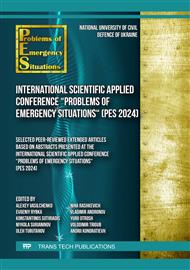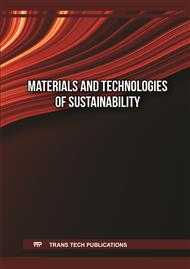[1]
Z.-M. Luo, F. Nan, F.-M. Cheng, R.-K. Li, B. Su, Study on the inhibition of hydrogen explosion pressure and flame propagation by trifluoroiodomethane. International Journal of Hydrogen Energy. 49 (2023) 670–680.
DOI: 10.1016/j.ijhydene.2023.10.182
Google Scholar
[2]
S. Li, X. Zhang, X. Li, X. Wang, J. Li, Theoretical and experimental studies on the thermal decomposition and fire-extinguishing performance of 1,1,2,3,3,3-hexafluoro-1-propene (R1216). International Journal of Quantum Chemistry. 123(22) (2023) e27217.
DOI: 10.1002/qua.27217
Google Scholar
[3]
X. Mu, H. Cong, Z. Shao, Bi M. Mingshu, X. Wang, Experimental and theoretical research on the inhibition performance of ethanol gasoline/air explosion by C6F12O. Journal of Loss Prevention in the Process Industries. 83 (2023) 105088.
DOI: 10.1016/j.jlp.2023.105088
Google Scholar
[4]
J. Zhao, Y. Wang, B. Zhou, H. Bian, Chemical mechanism and atmospheric degradation of C4F9N initiated by OH radical: Ab initio kinetic exploration. International Journal of Quantum Chemistry. 123(5) (2023) e27049.
DOI: 10.22541/au.164673561.13149165/v1
Google Scholar
[5]
R.E. Banks, E.K. Clarke, E.P. Johnson, P.N. Sharratt, Environmental Aspects of Fluorinated Materials: Part 31: Comparative Life-cycle Assessment of the Impacts Associated with Fire Extinguishants HFC-227ea and IG-541. Process Safety and Environmental Protection. 3 (76) (1998) 229-238.
DOI: 10.1205/095758298529533
Google Scholar
[6]
V.I. Babushok, D.R. Burgess, M.J. Hegetschweiler, G.T. Linteris, Flame propagation in the mixtures of O2/N2 oxidizer with fluorinated propene refrigerants (CH2CFCF3, CHFCHCF3, CH2CHCF3). Combustion Science and Technology. 11(193) (2021) 1949–1972.
DOI: 10.1080/00102202.2020.1720663
Google Scholar
[7]
S. Góger, P. Szabó, G. Czakó, G. Lendvay, Flame Inhibition Chemistry: Rate Coefficients of the Reactions of HBr with CH3 and OH Radicals at High Temperatures Determined by Quasiclassical Trajectory Calculations. Energy and Fuels. 32(10) (2018) 10100–10105.
DOI: 10.1021/acs.energyfuels.8b00989
Google Scholar
[8]
H. Liang, T. Wang, Z. Luo, J. Deng, J. Shi, Investigation on the lower flammability limit and critical inhibition concentration of hydrogen under the influence of inhibitors. Fuel. 356 (2024) 129595.
DOI: 10.1016/j.fuel.2023.129595
Google Scholar
[9]
M. Gao, M. Bi, L. Ye, C. Yan, W. Gao, Suppression of hydrogen-air explosions by hydrofluorocarbons. Process Safety and Environmental Protection. 145 (2021) 378–387.
DOI: 10.1016/j.psep.2020.08.036
Google Scholar
[10]
J. Zhang, W. Gao, L. Chen, Y. Li, Inhibition and enhancement of hydrogen explosion by perfluorohexanone. International Journal of Hydrogen Energy. 53 (2024) 522–534.
DOI: 10.1016/j.ijhydene.2023.11.311
Google Scholar
[11]
R.K. Viswanath, F. Takahashi, T. G. Linteris, Fire-suppression characteristics of CF3H in a cup burner. Combustion and Flame. 144 (2006) 645–661.
DOI: 10.1016/j.combustflame.2005.09.006
Google Scholar
[12]
F. Takahashi, V.R. Katta, G.T. Linteris, V.I. Babushok, A computational study of extinguishment and enhancement of propane cup-burner flames by halon and alternative agents. Fire Safety Journal. 91 (2017) 688–694.
DOI: 10.1016/j.firesaf.2017.04.010
Google Scholar
[13]
B.G. Tagiev, G.M. Niftiev, F.Sh. Aidaev, Photoluminescence and electroluminescence of GaS: Tm single crystals. Solid State Communications. 4(55) (1985) 385–386.
DOI: 10.1016/0038-1098(85)90629-5
Google Scholar
[14]
Y. Tsapko, K. Sokolenko, R. Vasylyshyn, O. Melnyk, A. Tsapko, O. Bondarenko, A. Karpuk, Establishing patterns of nitrogen application for fire safety of sunflower grain storage facilities. Eastern-European Journal of Enterprise Technologies. 10 (119) (5) (2022) 57–65.
DOI: 10.15587/1729-4061.2022.266014
Google Scholar
[15]
R. Likhnyovskyi, Y. Tsapko, V. Kovalenko, A. Onyshchuk, The Possibility of Using 1301 and 2402 Mixtures of Halons for Fire Extinguishing Purposes. Key Engineering Materials. 954 (2023) 135–144.
DOI: 10.4028/p-coko1k
Google Scholar
[16]
ISO 14520-1. Gaseous fire-extinguishing systems. Physical properties and system design. Part 1: General requirements. 2023. 106. https://www.iso.org/standard/79444.html
DOI: 10.3403/02399462u
Google Scholar
[17]
R. Likhnyovskyi, A. Tsapko, V. Kovalenko, O. Slutska, P. Illiuchenko, R. Kravchenko, M. Sukhanevych, Determining the thermal-physical characteristics of a coke foam layer in the fire protection of cable articles with foaming coating. Eastern-European Journal of Enterprise Technologies. 10 (122) (2023) 22–30.
DOI: 10.15587/1729-4061.2023.275550
Google Scholar
[18]
Y. Tsapko, R. Likhnyovskyi, A. Tsapko, V. Kovalenko, O. Slutska, P. Illiuchenko, K. Sokolenko, Y. Gulyk, Determining the patterns of extinguishing polar flammable liquids with a film-forming foaming agent. Eastern-European Journal of Enterprise Technologies. 3/10 (123) (2023) 48–56.
DOI: 10.15587/1729-4061.2023.278910
Google Scholar
[19]
H. Ji, Y. Li, H. Su, W. Cheng, X. Wu, Experimental investigation on the cooling and inerting effects of liquid nitrogen injected into a confined space. Symmetry. 11(4) ( 2019) 579.
DOI: 10.3390/sym11040579
Google Scholar
[20]
H. Liu, F. Wang, Research on N2 - inhibitor-water mist fire prevention and extinguishing technology and equipment in coal mine goaf. PLoS ONE. 14(9) (2019) e0222003.
DOI: 10.1371/journal.pone.0222003
Google Scholar



